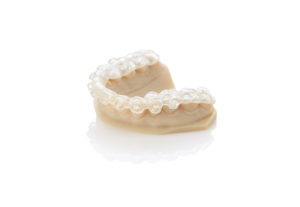Today marks another investment in the field of digital dentistry. After DWS Systems and Carbon’s announcements, it is up to Stratasys to unveil its strategy for the digital dentistry market. The provider of 3D printing services has unveiled a series of professional 3D printers designed for a range of dental laboratories.
The announcement has been made at LMT Lab Day, Chicago 2018 yesterday.
Stratasys’ new 3D printing technologies
This series of new 3D printers will enable to advance lab service offerings, cut production times, reduce costs, and support mass adoption of digital dentistry.
Called Objet260 Dental, Stratasys 3D Printer is based on PolyJet triple-jetting technology. It is capable of 3D printing 3 different materials on a single tray, and has the capacities to make surgical guides, models, and appliances according to a variety of requirements.

The main advantage of this technology is that scientists gain production efficiency while saving time and avoiding material waste. Convenient for mid-sized labs, the Stratasys Objet260 Dental 3D Printer is additionally upgradeable to “Dental Selection” – broadening adoption of next-generation digitally mixed materials.
“There’s no denying the power of 3D printing for digital dentistry to significantly decrease turnaround time, reduce labor costs, and provide new streams of revenue.” said Mike Gaisford, Director of Healthcare Solutions at Stratasys.
Other products to be showcased at the show
At LMT Lab Day, the company will demonstrate a flexible biocompatible material, MEDFLX625. Used with PolyJet multi-material 3D printers it helps laboratories further increase efficiencies by 3D printing both surgical guides and soft-tissue implant models during a single print run.
Stratasys’ new Pop-Out Part (PoP) technology for highly simplified and efficient workflows of dental part support removal, specifically clear aligner arches. Shown as a technology demonstrator, PoP speeds manual peel-off support for removal of up to 500 parts per hour, per operator. The solution eases use of additive manufacturing for high-volume 3D printing applications, allowing producers to clean thousands of arches with minimal investment in equipment or labor.
For further information about 3D Printing, follow us on our social networks and subscribe to our newsletter!





